Sights and Sounds of Heron Island
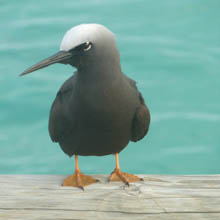
It’s amazing how many people who visit Heron Island complain about bird noise and bird poop.
Excited about a future trip to Heron Island, and the many opportunities for procrastination that offered, I spent a lot of time surfing the Internet, looking at photos and reading Trip Advisor reviews. I dressed this up as research because I would be visiting Heron Island on a press trip with my family and writing about it for my blog and various print publications.
From all that research I learn that it’s not called Heron Island for nothing, but when I get there I’m still surprised by how many birds there are.
As soon as you step off the boat and walk off the jetty you’re surrounded by birds. Black Noddy Terns are nesting, flying and landing everywhere.
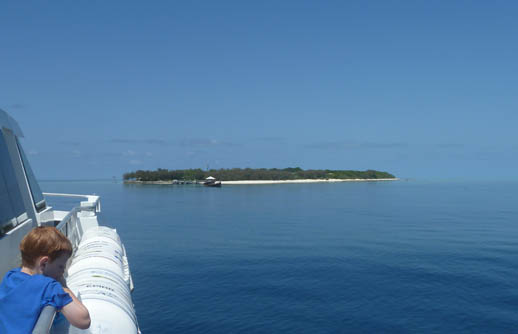
It’s a two-hour boat ride from Gladstone to Heron Island. I loaded the kids with seasickness pills as I heard it can be a rough ride but it was smooth sailing for us all the way.
Pausing to look up as we walk under another tree laden with birds I comment to Abbie, the Heron Island Resort staffer who’s come to meet us at the jetty,
“Wow! These birds are amazing, they’re so close to us, you could reach out and touch them.”
“Yes,” she nods kindly. She must hear this from visitors every day.
“Do you ever get fed up of the birds? Or just not notice them any more?” I ask her.
“No,” she replies “I love them. But you do learn to walk under trees quickly.”
So we hurried on to the bar where we were handed a cool drink and briefed on how to live side by side with the birds of Heron Island.
The Buff-Banded Rails are clever and regularly trespass into the restaurant and bar. We must not feed them. These small birds look cute as they roam around in the undergrowth and dash across paths with their chicks but, unusually for a bird, they have that deadly combination of good looks AND a brain.
I never see the Buff-Banded Rails fly but in 1998, when a few of the worst food-thieving offenders were tagged and shipped off to North West Island fly they did, straight back at Heron Island where they arrived before the boat that had deported them.
Then there are the Silver Sea Gulls who will snatch fruit from drinks and grab pizza crusts. We will need to take our food and drinks inside immediately after finishing them to outwit the Gulls.
Meanwhile the Wedge-Tailed Shearwaters are out at sea during the day but will return in the evening to their underground burrows where they sing all night. They are terrible singers but have other talents. These Shearwaters, or Mutton birds, can switch off half their brain for sleep while keeping the other half of their brain alert so they can also shriek from dusk until dawn.
Ear plugs are supplied in all rooms for humans who have not yet developed such a useful capacity.
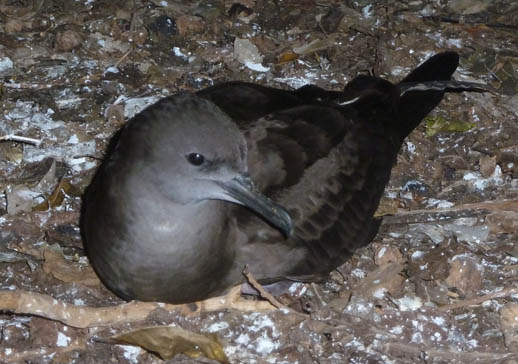
Thousands of Wedge-Tailed Shearwaters nest underground on Heron Island in the Great Barrier Reef.
During my three night stay on Heron Island I learn that there are 100,000 Black Noddy Terns currently breeding on this 40 acre coral cay located about 70 km (40 miles) off the Queensland coast. They are only here between November and April so it’s a privilege to be near them.
I take a free bird walk and learn more. The female Black Noddy Terns are sitting on their nests now, either incubating a single egg, or protecting their newly hatched chick. Meanwhile the males fly around looking for leaves which the female either approves and sticks onto the nest with poop or vetoes, sending him off to keep looking for a better leaf which meets her needs.
Despite these little disagreements the Black Noddy Terns are strictly monogamous, romantics who court each other every year. All day long we spot them flying in pairs to see if they are evenly matched and will be able to make it out to sea again when the time comes.
Apart from their colour Black Noddy Terns get their name because they drink sea water and desalinate it by squeezing out salty drops through their nasal passages with repeated head nodding. They remind me of those little nodding dogs people put on the back window of their car.
In the day time Black Noddy Terns often gather together in a sunny patch with their wings spread allowing their black feathers to heat up to 67 °C (152 °F) to kill ticks.
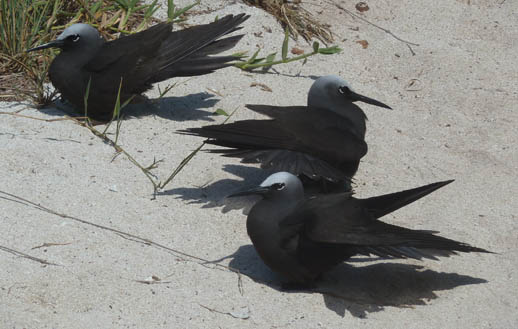
Black Noddy Terns sunning themselves in a clearing in the Pisonia forest on Heron Island.
But early in the year when the pisonia trees seeds fall to the ground birds of all species can get stuck to the ground by the sticky resin which glues their feathers together. There they will die, their bodies fertilising the trees which are their home.
That must be a sad sight but it’s a natural part of life on Heron Island and we are here for the nature.
Noisy birds and fishy smelling bird poop are nothing to complain about – just part of life on this pristine bird sanctuary.
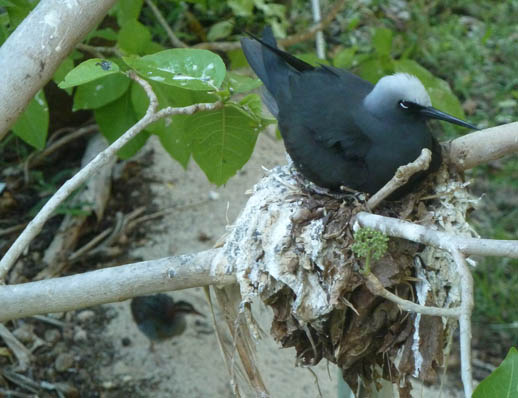
Black Noddy Tern sitting on its nest while a Buff-Banded Rail roams around on the sand underneath it.
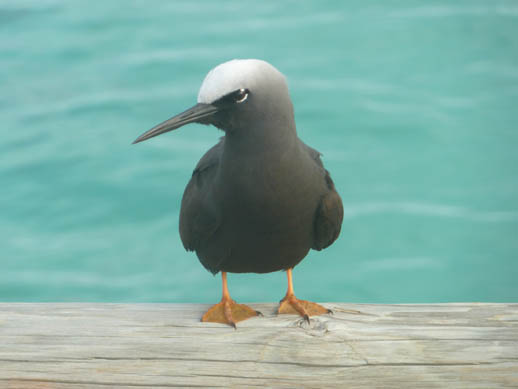
Just another photogenic Black Noddy Tern on Heron Island – a haven for birds and bird lovers.
I was a guest of Heron Island Resort. Check out their fabulous photos, take a virtual tour or plan your visit on their website.
Share This Story, Choose Your Platform!
6 Comments
Leave A Comment
You must be logged in to post a comment.


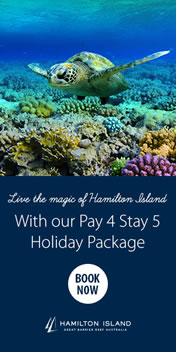






Oh, poor birds who get stuck in the pisonia tree seeds! That is sad :( but, as you say, it’s nature. Besides that depressing fact, ;) I really enjoyed your account of all the birds! I will most definitely not complain if I ever visit there.
Hi Gina,
Great to find another bird lover and hope you make it to Heron Island – it is a fabulous spot :)
Great pictures, The Heron Island is a great to take photos of birds and other animals. Are there other birds and animals in the Island besides Black Noddy birds?
Hi Omar,
Thank you. Yes, there are others seabirds and there’s a free bird spotting tour you can join.
Hi Annabel, thanks for the interesting footage on Heron Island. I’m reading everything about the island because I would like to go there on vacation. Do you think that it would be a good place to travel alone?
Nature is my main interest and specialy in such a paradise setting!
Hi Renee,
I’d say it’s a great place to travel alone because it’s totally safe and there are lots of free tours you can join with a group. If you like nature and beautiful scenery Heron Island is for you :)